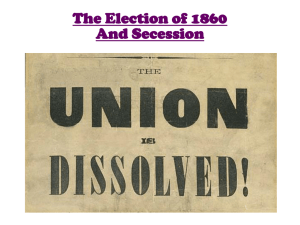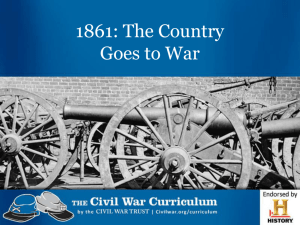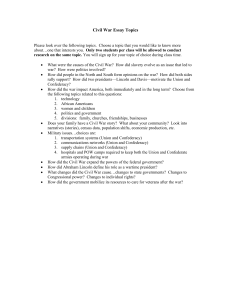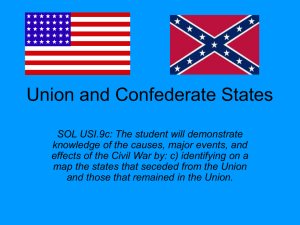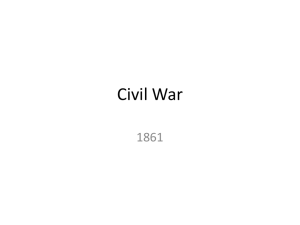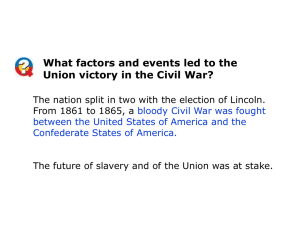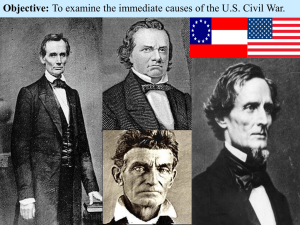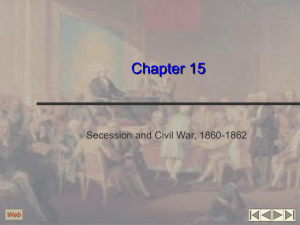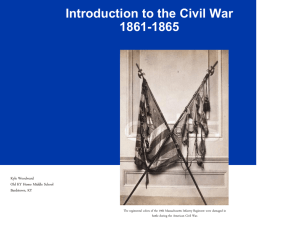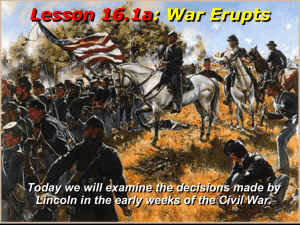Civil War Erupts
advertisement
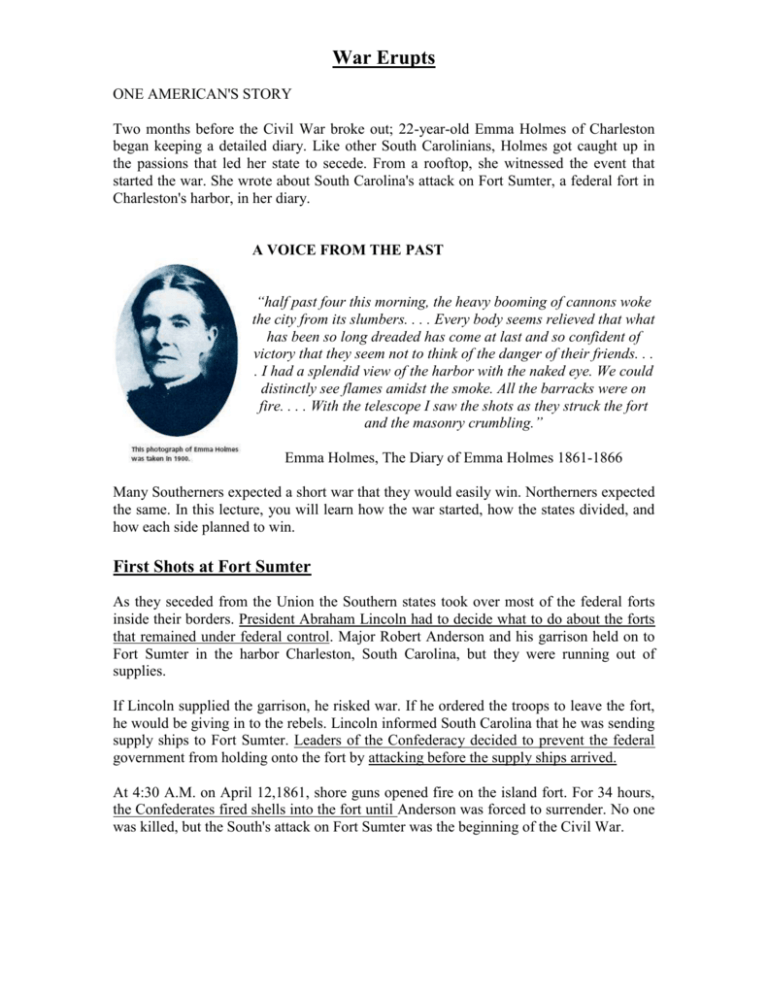
War Erupts ONE AMERICAN'S STORY Two months before the Civil War broke out; 22-year-old Emma Holmes of Charleston began keeping a detailed diary. Like other South Carolinians, Holmes got caught up in the passions that led her state to secede. From a rooftop, she witnessed the event that started the war. She wrote about South Carolina's attack on Fort Sumter, a federal fort in Charleston's harbor, in her diary. A VOICE FROM THE PAST “half past four this morning, the heavy booming of cannons woke the city from its slumbers. . . . Every body seems relieved that what has been so long dreaded has come at last and so confident of victory that they seem not to think of the danger of their friends. . . . I had a splendid view of the harbor with the naked eye. We could distinctly see flames amidst the smoke. All the barracks were on fire. . . . With the telescope I saw the shots as they struck the fort and the masonry crumbling.” Emma Holmes, The Diary of Emma Holmes 1861-1866 Many Southerners expected a short war that they would easily win. Northerners expected the same. In this lecture, you will learn how the war started, how the states divided, and how each side planned to win. First Shots at Fort Sumter As they seceded from the Union the Southern states took over most of the federal forts inside their borders. President Abraham Lincoln had to decide what to do about the forts that remained under federal control. Major Robert Anderson and his garrison held on to Fort Sumter in the harbor Charleston, South Carolina, but they were running out of supplies. If Lincoln supplied the garrison, he risked war. If he ordered the troops to leave the fort, he would be giving in to the rebels. Lincoln informed South Carolina that he was sending supply ships to Fort Sumter. Leaders of the Confederacy decided to prevent the federal government from holding onto the fort by attacking before the supply ships arrived. At 4:30 A.M. on April 12,1861, shore guns opened fire on the island fort. For 34 hours, the Confederates fired shells into the fort until Anderson was forced to surrender. No one was killed, but the South's attack on Fort Sumter was the beginning of the Civil War. Lincoln Calls Out the Militia Two days after the surrender of Fort Sumter, President Lincoln asked the Union states to provide 75,000 militiamen for 90 days to put down the uprising in the South. Citizens of the North responded with enthusiasm to the call to arms. A New York woman wrote, “It seems as if we never were alive till now; never had a country till now." In the upper South, however, state leaders responded with anger. The governor of Kentucky said that the state would "furnish no troops for the wicked purpose of subduing her sister Southern States." In the weeks that followed, Virginia, North Carolina, Tennessee, and Arkansas voted to join the Confederacy. As each state seceded, volunteers rushed to enlist, just as citizens did in the North. A young Arkansas enlistee wrote, 'So impatient did I become for starting that I felt like ten thousand pins were pricking me in every part of the body, and started off a week in advance of my brothers." Some feared the war would be over before they got the chance to fight. With Virginia on its side, the Confederacy had a much better chance for victory. Virginia was wealthy and populous, and the Confederacy in May of 1861 moved its capital to Richmond. Virginia also was the home of Robert E. Lee, a talented military leader. When Virginia seceded, Lee resigned from the United States Army and joined the Confederacy. Although Lee opposed slavery and secession, he explained, "I cannot raise my hand against my birthplace, my home, my children." He eventually became the commanding general of the Army of Northern Virginia. Choosing Sides After Virginia seceded, both sides knew that the Border States would play a key role in the war's outcome. The border states-Delaware, Maryland, Kentucky, and Missouri-were slave states that bordered states in which slavery was illegal. Because of their location and resources, the Border States could tip the scales toward one side. 2 Keeping Maryland in the Union was important for the North. If Maryland seceded, then Washington, D.C., would be cut off from the Union. To hold on to the state, Lincoln considered arresting Maryland law- makers who backed the South, but he decided against it. Pro-Union leaders eventually gained control of the Maryland legislature, and the state stayed in the Union. Kentucky was also important to both sides because of its rivers. For the Union, the rivers could provide an invasion route into the South. For the South, the rivers could provide a barrier. Kentuckians were deeply divided over secession. However, a Confederate invasion in 1861 prompted the state to stay in the Union. Both Missouri and Delaware also stayed in the Union. In Virginia, federal troops helped a group of western counties break away. These counties formed the state of West Virginia and returned to the Union. In the end, 24 states made up the Union and 11 joined the Confederacy. Strengths and Weaknesses The Union had huge advantages in manpower and resources. The North had about 22 million people. The Confederacy had roughly 9 million, of whom about 3.5 million were slaves. About 85 percent of the nation’s factories were located in the North. The North had more than double the railroad mileage of the South. Almost all the naval power and shipyards belonged to the North. The Unions greatest asset, however, was President Abraham Lincoln. He developed into a remarkable leader. Lincoln convinced Northerners that democracy depended on preserving the Union. The Confederacy had some advantages, too. It began the war with able generals, such as Robert E. Lee. It also had the advantage of fighting a defensive war. This meant Northern supply lines would have to be stretched very far. In addition, soldiers defending their homes have more will to fight than invaders do. The Confederate Strategy At first, the Confederacy took a defensive position. It did not want to conquer the Northit only wanted to be independent. "All we ask is to be let alone," said Confederate President Jefferson Davis. Confederate leaders hoped the North would soon tire of the war and accept Southern independence. The South also depended on King Cotton as a way to win foreign support. Cotton was king because Southern cotton was important in the world market. The South grew most of the cotton for Europe's textile mills. When the war broke out, Southern planters withheld cotton from the market. They hoped to force France and Britain to aid the Confederate cause. But in 1861, European nations had surplus cotton because of a big 3 crop the year before. They did not want to get involved in the American war. As the war heated up, the South soon moved away from its cautious plans. It began to take the offensive and try for big victories to wreck Northern morale. The Union Strategy The North wanted to bring the Southern states back into the Union. To do this, the North developed an offensive strategy based on General Winfield Scott's Anaconda Plan. This plan was designed to smother the South's economy like a giant anaconda snake squeezing its prey. The plan called for a naval blockade of the South's coastline. In a blockade, armed forces prevent the transportation of goods or people into or out of an area. The plan also called for the Union to gain control of the Mississippi River. This would split the Confederacy in two. One of the drawbacks of Scott's plan was that it would take time to work. But many people, eager for action, were calling for an immediate attack on Richmond, the Confederate capital. Lincoln ordered an invasion of Virginia in the summer of 1861. Battle of Bull Run To take Richmond, the Union army would first have to defeat the Confederate troops stationed at the town of Manassas, Virginia. This was a railway center southwest of Washington, D.C. On July 21, 1861, Union forces commanded by General Irvin McDowell clashed with Confederate forces headed by General Pierre Beauregard near a little creek called Bull Run north of Manassas. In the North, this battle came to be known as the First Battle of Bull Run. At one point in the battle, a Confederate officer rallied his troops by pointing his sword toward Southern General Thomas J. Jackson. The officer cried, "There is Jackson standing like a stone wall! Rally behind the Virginians!" From this incident, Jackson won the nickname "Stonewall" Jackson. His men held fast against the Union assault. As fresh troops arrived, the Confederates equaled the Union forces in number and launched a countercharge. Attacking the Union line, they let out a blood-curdling scream. This scream, later called the "rebel yell," caused the Union troops to panic. They broke ranks and scattered. The Confederate victory in the First Battle of Bull Run thrilled the South and shocked the North. Many in the South thought the war was won. The North realized it had underestimated its opponent. Lincoln sent the 90-day militias home and called for a real army of 500,000 volunteers for three years. 4

